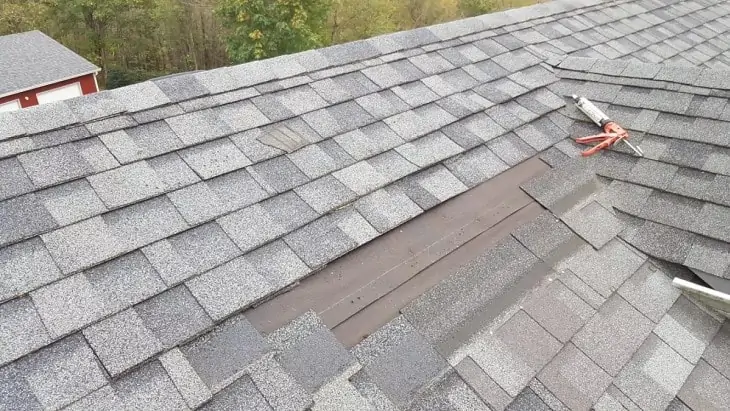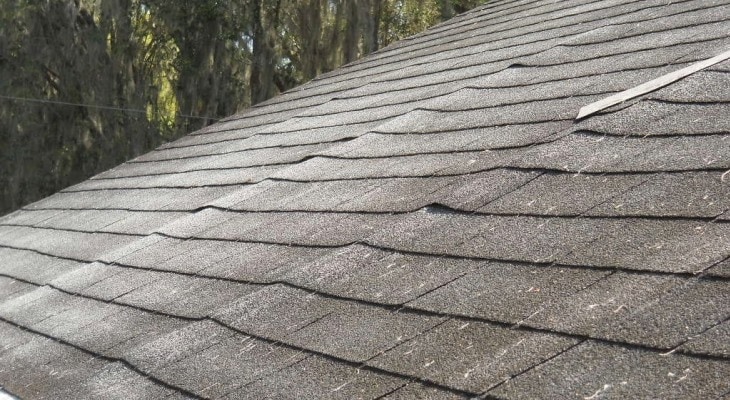Hopefully, none of us really need to think much about our roofs. The roof should just stay up there, do its job, and not give us any cause for concern. Reroofing is an expensive, time-consuming job! If you are concerned that your roof is sagging and may need to be repaired or replaced, keep reading.
If there are any low or curved points on a roof, that is a sign of roof sag. It can be caused by age, structural issues with the home or roof, water damage, or too much weight on the roof. Just about any roof sag is unacceptable. Roof sag indicates that repairs need to be made as soon as possible before further damage occurs.
Table of Contents
What Is Roof Sag?

Your roof should look like it is in a straight line, without any wavy or curvy parts. Low or wavy spots are an indicator of roof sag. There are quite a few reasons that a roof can sag. Do not walk on a sagging roof! It could give way, resulting in serious injury.
How Much Roof Sag is Acceptable?
The answer? Not much! Any sagging is a cause for concern and needs to be addressed. Roof sag is often an indicator of another problem. In turn, the sagging roof will just cause additional problems down the line.
Unfortunately, once a roof starts to sag, it will only get worse. If you notice any roof sag, address the issue immediately.
How Can I Check for Roof Sag?
Sometimes, a visual check is all you need! Sight down the roof line and mark any low points. Check the roof from all angles.
Exterior Inspection
If you want a specific number, use a string and pull it straight across the ridge line. Measure the gap between the string and the lowest point of the roof. Take careful note of the measurements.
Interior Inspection
Look for coordinating low spots from your outdoor inspection. Make sure all the rafter ties are in place and in good repair. Check the underside of the roof where you noted sagging on the outside. Look for bowing between the rafters. Also take note of any water stains, wet spots, or leaks.
What Causes Roof Sag?
There are a number of reasons a roof may sag. If your roof is sagging, consult with a professional roofer to diagnose and fix your roof issues.
Water Damage
Water can seep into the roof and cause structural damage. If you see moss or mold growing on your roof, that is a tell-tale sign that there is water damage.
Poor Design
Unfortunately, some homes are just not built well. There should be sufficient trusses, rafters, and supports within a home to support the roof well. If a builder is inexperienced or just cuts corners, it could result in a sagging roof.
Insufficient Internal Bracing

The trusses and supports underneath the roof are important! If the braces aren’t up to the job, the roof will sag. Insufficient bracing may be caused by a number of things:
- The wrong size of trusses or rafters were used by the builder.
- The current supports aren’t up to the weight of the roof.
- A contractor or homeowner removed supports.
- One or more supports are cracked or broken.
Too Much Weight
Often, when a roof is replaced, the old roof is not removed and the new roof is placed on top. Roof coatings are heavy! If your roof has two or three layers of roof coatings, the weight could cause sagging.
Certain roof coverings can add weight as well. Concrete roof tiles are a weighty roofing choice. A switch from traditional shingles to a tile roof should be done by a professional, and the roof should be monitored afterwards. Additional supports may be needed.
Snow and ice build up can be heavy! If you notice your roof sagging in the winter, make sure to clear off any snow or ice.
Age
Homes and roofs will deteriorate over time. Keep roofs in older homes from sagging by proper maintenance and reinforcement.
Structure Issues in the Home
A house does settle over time. However, if there is dramatic settling in the foundation, it could compromise the roof, too.

